In early January, Forest City Ratner became the latest prominent real estate company to ditch the secrecy of private ownership in exchange for the tax benefits and easier access to capital that come with being a public company.
And they are just the latest firm to join the real estate investment trust ranks.
For stock investors, the proliferation of REITs means more choices — and with that more confusion, given that many invest in similar assets.
This month, The Real Deal crunched the numbers to find out which REITs and public real estate firms performed best over the past five years.
We looked at the five that have the most money invested in Manhattan — Equity Residential, Boston Properties, SL Green Realty, Brookfield Asset Management and Vornado Realty Trust.
Then we ranked them on one simple criterion: If an investor had bought $1,000 worth of shares five years ago and sold today, what would they have made? (TRD’s number includes the stock appreciation and total dividend payments earned over the five-year period between mid-January 2011 to the middle of last month, but does not included reinvested dividends.)
Among the five, Equity was the only stock that outperformed the S&P 500 index’s 45 percent growth during the period we reviewed, though several of the REITs had higher returns when dividends were factored in.
Below is a rundown of who performed best and why.
Equity Residential
Gross profit on $1,000: $728
Sam Zell’s Chicago-based multifamily REIT tops TRD’s ranking. Investors who bought $1,000 worth of stocks in January 2011 would get back $1,728 today — or a 72 percent return on their investment.
The strong performance reflects smart investment decisions early in the market cycle, explained Alexander Goldfarb, an analyst at the investment banking firm Sandler O’Neill. “Equity Residential was one of the first to start buying again after the credit crisis,” he said. “They were prescient and willing to step into the market when others weren’t.”
Indeed, in February 2010, the company bought the Manhattan apartment buildings RiverTower, Longacre House and 777 Sixth Avenue from embattled developer Harry Macklowe for a combined $475 million — a bargain price in hindsight.
In November 2015, Equity went into contract to sell the 323-unit RiverTower, located at 420 East 54th Street, to Slate Property Group and GreenOak Real Estate for $390 million. That came on the heels of a massive $5.4 billion sale of a 23,000-apartment portfolio in secondary suburban cities to Starwood Capital Group.
Equity’s knack for buying buildings at the bottom of the market is not just the result of vision, but also of having sufficient cash reserves at the right time, explained Goldfarb. Unlike some other multifamily REITs, Equity wasn’t tied up in expensive construction projects early in the cycle, meaning it had more money to spend on acquisitions.
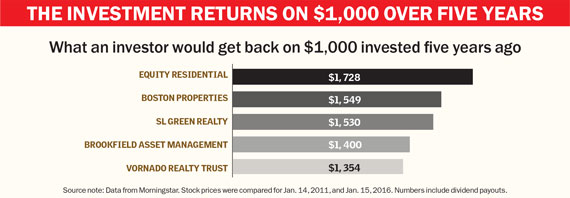 There is also a more simplistic explanation for why Equity has outperformed rivals like SL Green, Boston Properties, Brookfield and Vornado — all REITs that get most, or all, of their income from office buildings. Office leases are usually signed on a long-term basis, while apartment leases renew every year or two. When the market booms, residential REITs can increase their income stream by raising rents, while office REITs have to wait for longer-term leases to expire.
There is also a more simplistic explanation for why Equity has outperformed rivals like SL Green, Boston Properties, Brookfield and Vornado — all REITs that get most, or all, of their income from office buildings. Office leases are usually signed on a long-term basis, while apartment leases renew every year or two. When the market booms, residential REITs can increase their income stream by raising rents, while office REITs have to wait for longer-term leases to expire.
On the flip side, when the market goes south, multifamily REITs can see their income shrink faster than office REITs. That’s why Equity is, perhaps, the most vulnerable of the five firms that TRD ranked to a real estate market downturn.
“Equity Residential is a proxy for the apartment world, and there will be an almost inevitable slowdown in rent growth given the new supply coming in,” said John Guinee, an analyst at investment services firm Stifel who tracks the firm.
Boston Properties
Gross profit on $1,000: $549
If you had invested $1,000 in Boston Properties in 2011, you would have gotten back $1,549 last month.
While the company’s stock rose less than SL Green’s, the company paid out more dividends, meaning an investor would have earned more with Boston Properties.
Like Equity, Boston Properties’ strong performance is largely a result of big — and early — investments it made in this economic cycle. And again, Macklowe was a key figure. In 2008, when the developer defaulted on loans for the $7 billion portfolio once owned by Equity Office, he was forced to sell his most prized asset: Manhattan’s GM Building. At a time when few firms had billions to spare, Boston Properties was there to pick it up for $2.9 billion, which proved to be a good price.
Like Equity, Boston Properties, which is headed by Mort Zuckerman, has a reputation as a savvy seller at the top of the market. Since 2011, the Boston-based REIT has sold $4.4 billion worth of assets, according to John Kim, an analyst at the financial service firm BMO Capital Markets. While Equity sold far more — unloading $13.2 billion — Boston Properties netted higher average profits on its sales. It fetched 46 percent versus Equity’s 40 percent return on investment, according to Kim.
The REIT also benefitted from its exposure to the Boston and San Francisco office markets, which grew at a faster clip than Manhattan in recent years, explained Stifel’s Guinee.
Nonetheless, that exposure to non-New York markets could pose a risk going forward.
Some analysts don’t expect those markets to perform as well as New York in the coming years. San Francisco, where Boston Properties is building the city’s tallest tower, the $1.1 billion, 1,070-foot-tall Salesforce Tower, is a particular worry to investors because of its dependence on the volatile tech sector.
The REIT also has a $2.7 billion development pipeline, according to Green Street Advisors, which tracks the sector. In Brooklyn, for example, the firm is developing a $410 million office building in the Navy Yard with shared-office company WeWork as an anchor tenant. Pipelines that large can pose risks if the market turns.
Still, analysts who talked to TRD expect Boston Properties’ stock to outperform its rival REITs in the coming years.
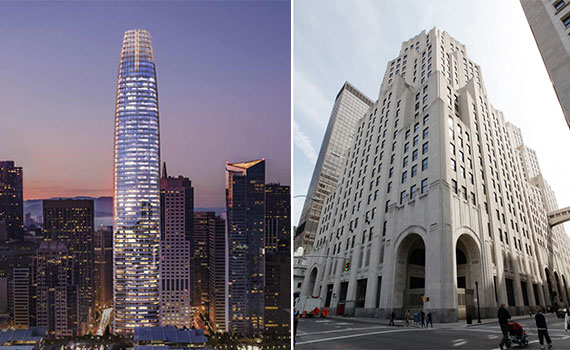
A rending of Salesforce Tower in San Francisco and 11 Madison
The firm has around $1.4 billion in cash reserves, which mitigates the risk from its development projects. And in San Francisco, strong leasing interest in the Salesforce Tower has already “helped calm investor fears of Bay Area tech market shakiness,” according to Green Street. (Salesforce, the cloud computing company, leased 714,000 square feet — or about half the tower — for 15 years.)
“Development is part of their core competencies and they have been successful over time,” added Sandler O’Neill’s Goldfarb.
Furthermore, Boston Properties’ portfolio of existing buildings has a large number of below-market leases set to expire, meaning the REIT can likely increase its income stream with little effort. One prominent example is the former FAO Schwarz space in the GM Building. The famed toy store, which recently vacated the space, reportedly paid about $260 per square foot in rent for the space. Current asking rents on that stretch of Fifth Avenue, by comparison, are $3,500 per square foot, according to Cushman & Wakefield.
SL Green Realty
Gross profit on $1,000: $530
SL Green’s stock performance trails Boston Properties’ just slightly. An investor’s $1,000 in 2011 would have grown to $1,530 by last month.
“Those companies are almost on top of each other,” said Stifel’s Guinee.
The REIT’s strong performance is essentially a direct reflection of the health of Manhattan’s office market. That’s because a stunning 95 percent of SL Green’s income is generated in Manhattan, according to Guinee. By comparison, that figure stands at around 40 percent for Boston Properties and less than 20 percent for Equity Residential.
So after years of rising Manhattan office rents and an office availability rate that is the lowest since 2008, it’s no surprise SL Green’s stock has done well.
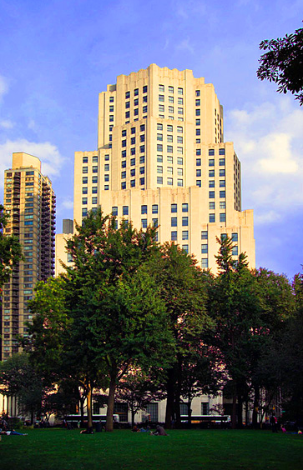
11 Madison Avenue
In August, the REIT, which is helmed by Marc Holliday, closed on the acquisition of 11 Madison Avenue for roughly $2.3 billion — the second-priciest single-asset deal of the year. Since then, it has dished out $127 million to take full ownership of 600 Lexington Avenue (it previously owned 55 percent) and bought three Downtown properties for a combined $300 million, bringing its total acquisition volume in Manhattan in 2015 to more than $3 billion.
While Equity Residential, Boston Properties and SL Green have all mastered the art of selling when the market is high, SL Green is more apt to use that cash to reinvest in additional purchases.
“Equity Residential and Boston Properties — sometimes they’ll just pick the top of the market and say, ‘This is it,’ and not buy anymore,” said BMO Capital’s Kim. “SL Green channels it back into acquisitions.”
According to Kim, many investors didn’t like the 11 Madison acquisition because of its low 4.6 percent cap rate and because the building offers little short-term potential for hefty profits.
And that wasn’t the only deal that confounded observers.
In 2011, the REIT took over a 49.9 percent stake in the Moinian Group’s 180 Maiden Lane in return for a $280 million loan, with plans to renovate and reposition it into a cheaper Class A office alternative to the World Trade Center. The deal valued the property at about $425 million. Instead, the partners sold the tower three years later, after upgrading it, for $470 million.
“That confused a lot of people because the story they told people was not what they ended up doing,” said Goldfarb. The company declined to comment for this story.
Despite the mixed reaction to the 11 Madison buy, analysts who spoke to TRD are bullish on the REIT’s near future. It may have paid a pretty penny for the Art Deco office tower, but it followed that deal with a selling spree of office and retail buildings in Manhattan, netting more than $1 billion. Since many of these deals sold at a lower cap rate than the 11 Madison purchase, SL Green’s balance sheet is arguably in better shape today.
Analysts are also bullish on One Vanderbilt, the 1,500-foot-tall office tower the REIT is building next to Grand Central Terminal, and its first construction project of that size. A project of that ilk normally causes jitters among investors, but the opposite seems to be true in this case.
“I think SL Green is going into battle with probably the best site in New York and will need rents to match, but you figure there are enough tenants in New York who crave that location,” said Goldfarb.
Brookfield Asset Management
Gross profit on $1,000: $400
The investors who snapped up $1,000 in Brookfield Asset Management stocks back in 2011 would be $400 richer today.
But unlike the other companies on the ranking, the Toronto-based firm is technically not a REIT, though it is a large publicly traded owner of commercial real estate in Manhattan.
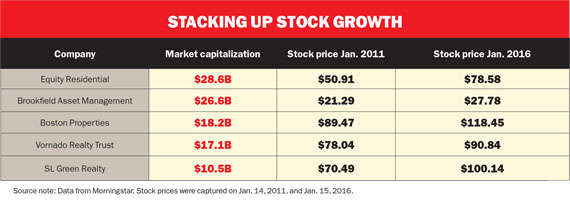 Yet unlike the other companies, the firm is a massive global conglomerate with $200 billion in assets under management — far more than any of the REITs ranked here. As a result, its stock price can be influenced by an infinite number of factors.
Yet unlike the other companies, the firm is a massive global conglomerate with $200 billion in assets under management — far more than any of the REITs ranked here. As a result, its stock price can be influenced by an infinite number of factors.
Much of Brookfield’s income comes from the fees it gets for managing private funds, rather than from real estate directly. That means that some typical REIT investors shy away from Brookfield, whose real estate operations are headed by Ric Clark.
“REIT investors like to own the companies that own the assets directly,” said BMO Capital’s Kim.
Its subsidiary Brookfield Property Partners, however, is an incredibly active commercial property owner and developer in Manhattan. That company — which only went public in 2013 — recently completed a massive renovation of the sprawling World Financial Center in Lower Manhattan. The property, which it renamed Brookfield Place, signed several high-profile leases, most notably a 700,000-square-foot deal with Time Inc., and reportedly has a vacancy rate in the single digits, down from more than 40 percent in late 2013. It’s also signed on retail tenants like Burberry and J. Crew and added two trendy 30,000-square-foot food halls, Le District and Hudson Eats.
Meanwhile, on the Far West Side, it’s developing the $8.6 billion mixed-use complex Manhattan West. In April, it signed law firm Skadden, Arps, Meagher and Flom to a 550,000-square-foot lease at One Manhattan West, paving the way for construction to start at the first tower. In October, Brookfield sold a 44 percent stake in the project to the sovereign wealth fund Qatar Investment Authority.
Vornado Realty Trust
Gross profit on $1,000: $354
With an average annual return of more than 9 percent over the past five years, Vornado’s stock has hardly been a disaster. But it still trails the other companies on TRD’s ranking.
A $1,000 investment in 2011 would have netted an increase of just $354 by last month.
Part of that less-than-stellar performance can be traced to its ill-fated investment in JCPenney and Toys “R” Us, which have both been struggling.
In 2010, Vornado, which was founded by Steven Roth, bought a 10 percent stake in JCPenney. Three years later, it sold all its remaining shares for less than half what it had paid.
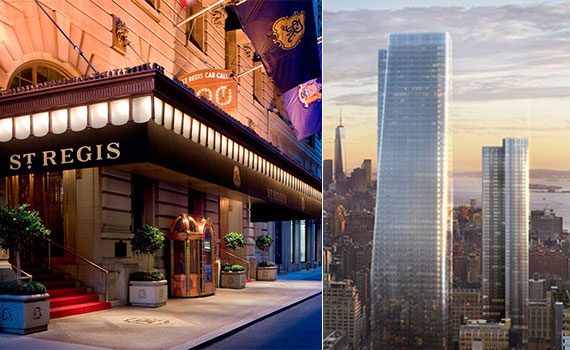
The St. Regis Hotel and A rendering of the mixed-used Manhattan West project on the Far West Side, which Brookfield is developing.
According to Sandler O’Neill’s Goldfarb, Vornado’s investments were too spread out early on in the cycle between its core real estate holdings (in New York and greater Washington, D.C.) and its investments in JCPenney and Toys “R” Us, both of which were a drag on profits.
“Steve [Roth] had to look into the mirror and ask himself, ‘What do I want this company to be?’” Goldfarb said.
He appears to have done just that.
The year 2013 was a big one at the REIT. Its CEO Michael Fascitelli stepped down, with Roth taking over. The company sold its JCPenney holdings and it refocused on urban office and retail buildings. (It still owns a minority stake in Toys “R” Us.) For example, it bought a stake (for an undisclosed amount) in the office building 650 Madison Avenue. Then in 2014, it paid $700 million in partnership with Crown Acquisitions for the retail condo at the St. Regis Hotel in Midtown.
“They deserve a lot of credit for turning the company around,” Goldfarb added.
Goldfarb believes that Vornado’s stock has strong growth potential. “Vornado has done a huge amount of leasing that I don’t think is fully appreciated by the market,” he said, adding that its real estate holdings in Northern Virginia should also do well if military spending ticks up.
Plus, the firm is developing one of Manhattan’s highest-profile and priciest luxury condo towers: 220 Central Park South. At a development cost of $5,000 per square foot, it is a risky bet amid a slowdown in the high-end residential market. But the tower has a projected sell out of $3.1 billion.
Stifel’s Guinee explained that while the tower has garnered plenty of press, it isn’t as significant to the REIT’s balance sheet.
Far more important is Vornado’s long-term bet on the office market around Penn Station, where it currently owns more than $5 billion in real estate. According to Guinee, Vornado has not explained its vision clearly for the Penn Station submarket or for its Central Park tower to investors — even though its strategy may be well mapped out.
“The street doesn’t give them a lot of credit,” he said. “The net-net is Vornado has to do a lot better job explaining what they’re doing at 220 Central Park South, and the opportunity and game plan at Penn Station.”
